
Blister Beetles of Montana
Blister beetles (meloid beetles) are leaf-feeding insects that secrete a liquid that can cause blisters, and can be toxic when accidentally fed to livestock in forage. Of nine species observed in Montana, only one has been reported to have damaged crops. This fact sheet describes the species found in Montana and discusses the risks of crop damage and livestock poisoning.
Last Updated: 04/17by Sue Blodgett, former MSU Extension IPM Specialist; Patricia M. Denke, former Research Associate, MSU Dept. of Entomology; and Virginia Knerr, Broadwater County MSU Extension Agent Reviewed by Kevin Wanner, Associate Professor, Plant Sciences and Plant Pathology
BLISTER BEETLES, ALSO CALLED MELOID BEETLES,
get their name from a toxin called cantharidin found in their body fluids. When the adult beetle is disturbed, “blood” containing this toxin is exuded from the leg joints. The fluid can cause blisters when it comes in contact with the skin.
Beetles killed during alfalfa harvest operations and incorporated into baled alfalfa can be toxic when fed to livestock. However, surveys of blister beetles species and seasonal occurrences conducted over several years in Montana have concluded that they are of minor concern to alfalfa producers or people who feed hay produced in Montana.
Damage and risk posed by blister beetles
Many species of blister beetles occur throughout the United States and Montana. The species group for each region, their seasonal occurrence, abundance during the growing season, and the beetles toxicity dictate the seriousness of this pest. Blister beetles are leaf-feeding pests of potato, sugarbeet, soybean and alfalfa. In Montana, they occur most frequently in alfalfa hay and canola, but have been reported from potato and other broadleaf crops.
Blister beetles can be both direct and indirect pests depending on the crop and damage potential. For example, they are not considered a direct pest in alfalfa forage, although adult feeding may cause localized defoliation. The primary concern with blister beetles in alfalfa is the potential of contaminating forage with the toxin, cantharidin. This happens when beetles are killed during alfalfa harvest and the dried beetles, which still contain the toxin, are incorporated into baled alfalfa.
In other crops such as canola, potatoes or sugarbeets, feeding by adult blister beetles may cause serious defoliation and may damage or destroy flowers or buds, both of which have impacts on yield and quality of the harvested crop. Blister beetles have been observed feeding on canola flowers and green seedpods in Montana but the economic impacts are not known.
In contrast to its damage potential, the most well- represented blister beetle genus in Montana, Epicauta, can also be considered beneficial because the immature beetles feed on grasshopper eggs.
Description
The blister beetle adult is distinguished by the long cylindrical soft body, with the tip of the abdomen extending beyond the end of the wing covers (elytra), chewing mouthparts, and a thorax (neck) narrower than both the head and the abdomen (Figure 1). Species range in size from ¼ inch to almost 13?4 inches. Individual species can be characterized by distinctive coloration and antennal characteristics.
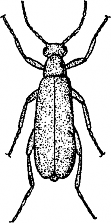
FIGURE 1. Typical blister beetle with distinct narrow neck, long, soft wing covers and tip of abdomen showing.
Illustration courtesy of North Dakota State University.
Life cycle
Blister beetles lay eggs in clusters of up to 100 in the soil. The eggs hatch within 14 days into tiny, mobile larvae, called triungulins, which move about, searching for food. The immature beetles feed on grasshopper egg pods or the larval cells of solitary bees, becoming increasingly sedentary as they feed. The larvae overwinter in the soil in a specialized form. In the spring, pupation occurs in response to increasing temperature and moisture. Blister beetles have one generation per year.
The adults emerge, usually from late May until mid-July, and begin to feed and lay eggs. Adults of each blister beetle species emerge successively during the growing season. Various blister beetle species may be found in Montana from May until mid- September (Table 1).
TABLE 1. Seasonal distribution of nine blister beetle species in Montana. Data optained from museum and field collected species.
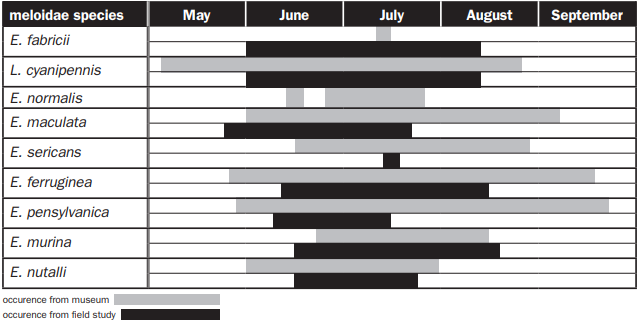
Crop damage and economic impact
Sugarbeets: Several species of blister beetles feed on sugarbeet foliage and may cause isolated patches of defoliation in the crop. Black, ash-gray and spotted beetle species have been documented on sugarbeets in Montana. However, economic infestations are rare.
Canola: A large (1 to 1¼ inch), purple and green iridescent beetle (Lytta nuttalli or Nuttall's blister beetle) can be found in Montana feeding on the leaves, stems and flowering heads of canola plants. This species can be found in dense groups on the edges of canola fields and have been observed moving from windbreaks of caragana hedges into flowering canola fields. From observations made on this species in Canada, they seemed to prefer low- (canola) rather than high -glucosinolate strains of rapeseed, and low- rather than high -coumarin strains of sweet clover. This species of blister beetle stands out because of its large size and metallic coloration. The defoliation damage that they cause does not have significant economic impact except when populations are extremely high or are concentrated on the buds and flowers. Treatment is not recommended under normal conditions.
Potatoes: Blister beetles can occur in mid-summer on potatoes and may cause extensive foliar damage. Typically, blister beetles may cause localized areas of foliage damage, but widespread economic damage is rarely encountered.
Risk posed by blister beetles in alfalfa hay
Although adult beetles feed on alfalfa foliage, their primary impact is not due to defoliation damage. Instead, blister beetles are of concern because they contain a toxin in their body fluids called cantharidin, a very stable compound. Blister beetles can be killed during hay harvest and incorporated into baled forage.
When hay containing blister beetles is ingested by sensitive livestock, blistering of the esophagus and stomach can occur, kidney and heart function can be impaired – and in severe cases, death can result. Horses are especially prone to blister beetle poisoning, which occurs when they feed on dried, baled forage containing the dried beetles.
Major species that occur in Montana.

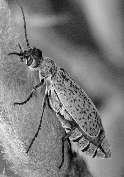
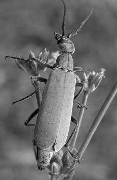

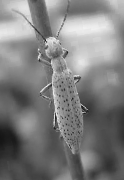
The risk of blister beetle poisoning depends on how much cantharidin is ingested. Several factors may effect the cantharidin concentration in the baled forage including the species of blister beetle, the beetle population, and its distribution or density within the field. Some species occur in very dense aggregations similar to that of a honeybee swarm and these species have been most frequently implicated in horse poisoning cases. Aggregations of blister beetles occur in localized areas of 100 to 200 sq. ft. In this case, only a few flakes from a bale of hay may contain blister beetles. However, the species that are known to cluster in swarms have not been found in Montana. Therefore, the risk of blister beetles to forage production is low in Montana.
How many blister beetles can kill a horse
Several factors contribute to the severity of blister beetle poisoning, including concentration of the toxin cantharidin, size and health of the horse, and the dosage (or number of beetles) consumed. John Capinera (formerly at Colorado State University) investigated the dosage of the toxin, cantharidin (contained in blister beetles), needed to kill horses of different sizes. The following table is taken from work that he published.
Although all blister beetle species contain some level of the toxin, cantharidin, only those species belonging to the 'Striped' or Vittata Group, that form dense aggregations have been documented to kill horses. These species have not been found to occur in Montana.
TABLE 2. Cantharidin toxicity in horses (study by Capinera, CSU)
| Cantharidin content in beetle (mg) | Beetles required to kill 550 lb horse | Beetles required to kill 825 lb horse |
| 1 mg | 250 beetles | 350 beetles |
| 3 mg | 83 beetles | 124 beetles |
| 5 mg | 50 beetles | 75 beetles |
Major species that occur in Montana
A survey of blister beetles in alfalfa was conducted during a four year study at Montana State University, 1994-1997 by the authors. Eight species were found to occur in Montana alfalfa (Table 1). Blister beetle collection information was also gathered from the museum collection, Montana Entomology Collection and used where host plant data are indicated. Epicauta normalis was not found in field collections, but specimens are present in the Montana Entomology Collection.
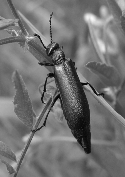
Management
Monitoring to detect the presence and type of blister beetle present is important. If blister beetles are present at harvest, it is important to use harvest equipment that allows the beetles to escape from mowed and swathed forage because the type of equipment and its operation has an impact on blister beetle mortality during hay harvest. Research at Kansas State University has shown that self-propelled swathers without conditioning rollers but with windrowing attachments are safer than mower conditioners and sicklebar mowers.
Sicklebar mowers, long recommended for reducing the potential for blister beetle incorporation into baled forage, were found to cause significant mortality if recently cut hay was driven over. Wheel traffic on recently mowed alfalfa hay caused mortality of those beetles remaining in the cut forage. Allowing beetles to disperse after mowing and before baling reduced the number of beetles incorporated into baled hay.
Insecticides can be used to reduce populations. However, since blister beetles are mobile and may move into the crop at any time, the residual activity of registered insecticides may not be sufficient to control blister beetles up to harvest.
Another strategy would be to treat immediately before harvest, but insecticides with zero-day preharvest intervals are not labeled for blister beetle control. Also, Kansas State University discourages the use of insecticides because it causes beetle mortality, resulting in beetles remaining in the forage.
Current insecticide recommendations can be found in the High Plains Integrated Pest Management Guide, located on the Web at http://highplainsipm.org/
Summary
The species that have been detected in Montana are not regarded as a significant problem because numbers are relatively low and occur infrequently. The species that are most frequently cited as the cause of horse deaths have not been found to occur in Montana.
TABLE 3. Summary of research observations.
| Species (common name) | Adult length | Coloring | Season of emergence | Plants observed feeding on | Damage reported |
Lytta cyanipennis |
¾ to 1¼ inch |
Head, thorax and wing covers deep metallic blue varying to green | March to August. In Montana primarily observed mid-June through mid-July | Lupine, vetch, pea, alfalfa and bean |
|
L. nuttalli(Nutall) |
¾ to 1¼ inch |
Head and thorax usually metallic green with wing covers metallic purple |
June and July |
Sweet clover, alfalfa, milkvetch, caragana, locoweed, vetch canola, barley, oat, beet and sainfoin | Reports of damage to canola, barley, oat, beet and sainfoin |
| Epicauta fabricii(ash gray) | 3/8 to 5/8 inch | Uniformly ash gray with black antennae | June through August | Alfalfa, sweet clover, wild indigo, soybean and locoweed | |
| Epicauta ferruginea | ¼ to ½ inch | Uniformly golden in color | May through August | Canola, alfalfa, sunflower, thistle, gumweed and lentil | |
| Epicata maculata (spotted) | ½ to 1 inch |
Characteristic black spots caused by the absenceof pubescence | June through July |
||
| Epicauta murina | ¼ to 3?8 inch | Dark gray | mid-June to mid-August | alfalfa | |
| Epicauta normalis(dark) | ½ to 1 inch | Gray with black spots (similar to E. maculata) | July | unknown | |
| Epicauta pennsylvanica (black) | ¼ to 5/8 inch |
Uniformly black |
June and July |
A wide range of plant hosts including crops such as alfalfa, sunflower, sugarbeets and weeds such as amaranthus, aster, night- shade, sage and yarrow | |
| Epicauta sericans | ¼ to 3/8 inch | Gray | July | Weeds such as goldenrod, bindweed and nightshade | |

